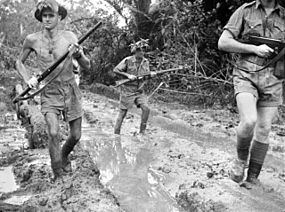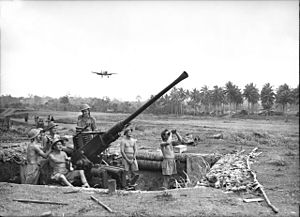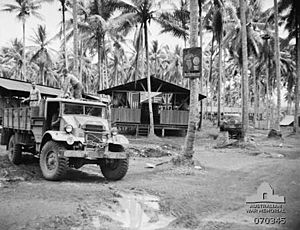Battle of Milne Bay facts for kids
Quick facts for kids Battle of Milne Bay |
|||||||
|---|---|---|---|---|---|---|---|
| Part of the New Guinea Campaign of the Pacific Theater (World War II) | |||||||
 Australian troops at Milne Bay in 1942, shortly after the battle |
|||||||
|
|||||||
| Belligerents | |||||||
| Commanders and leaders | |||||||
| Units involved | |||||||
Support elements of: |
|
||||||
| Strength | |||||||
| 8,824 | 1,943 Land Troops with Tanks | ||||||
| Casualties and losses | |||||||
Australia:
|
|
||||||
The Battle of Milne Bay was a key fight during World War II in the Pacific. It happened from August 25 to September 7, 1942. Japanese forces, mainly marines called Kaigun Tokubetsu Rikusentai, tried to capture Allied airfields at Milne Bay. This area is located on the eastern tip of New Guinea.
The Japanese thought the airfields were only lightly defended. They believed there were only a few hundred Allied soldiers. However, the Allies had been warned by secret intelligence. They had sent many more troops to defend the area. Most of these defenders were Australian soldiers.
The Japanese faced strong resistance and tough conditions. Their landing crafts were destroyed by Royal Australian Air Force (RAAF) planes. They also struggled with the muddy ground and heavy rain. Despite early pushes, the Japanese were outnumbered and lacked supplies. They were forced to retreat, marking a big victory for the Allies.
This battle was important because it was the first time Allied ground forces clearly defeated the Japanese in a major battle during the war. It showed that the Japanese were not unbeatable. This victory boosted Allied morale and helped them plan future operations.
Why Milne Bay Was Important
Location and Landscape
Milne Bay is a large, protected bay at the eastern end of Papua New Guinea. It is about 22 miles (35 km) long and 10 miles (16 km) wide. The bay is deep enough for big ships. This made it a great spot for a military base.
The land near the coast was flat, which was good for building airstrips. But it also had many rivers and swampy areas. Heavy rainfall, about 200 inches (5,080 mm) a year, often caused floods. This turned the ground into thick mud, making it hard to move around.
The area was also known for malaria. This disease, spread by mosquitoes, was a big problem for soldiers.
Building the Airfields
In 1942, the Japanese were trying to capture Port Moresby. This was a very important location. To protect Port Moresby, the Allied commander, General Douglas MacArthur, decided to build airbases.
Milne Bay was chosen because it was flat and had good access for ships. This made it easier to build airfields and bring in supplies. Bombers flying from Milne Bay could also reach Japanese bases without flying over high mountains.
The first Allied troops arrived at Milne Bay on June 25, 1942. They were mostly Australian and American engineers. They started building the first airfield, called No. 1 Airstrip.

By July 22, the first Kittyhawk fighter planes from the Royal Australian Air Force (RAAF) landed. But the runway was often wet and muddy. Planes sometimes skidded off.
Work began on two more airfields. The Japanese started bombing Milne Bay on August 4. They attacked the airfields and the engineers working there. Allied planes fought back, and a radar system was set up to give early warnings.
Allied Forces Gather
More Australian troops arrived in July and August. These included the 7th Infantry Brigade and the veteran 18th Infantry Brigade. By August 22, there were over 8,800 Australian and US soldiers at Milne Bay. About 4,500 of them were infantry (ground soldiers).
Major General Cyril Clowes took command of the Allied forces. He placed the less experienced 7th Brigade in defensive positions. The veteran 18th Brigade was kept ready for counterattacks. Moving around was hard due to the soft, muddy ground. Communication often relied on telephone cables or runners.
Japanese Plans
The Japanese discovered the Allied base at Milne Bay. They saw it as a threat to their plans to capture Port Moresby. Vice Admiral Gunichi Mikawa of the Imperial Japanese Navy (IJN) was ordered to capture Milne Bay. This operation was called RE.
The Japanese mistakenly thought Milne Bay was defended by only 300-600 Australian soldiers. So, their initial attack force was small, about 1,250 marines. They also had two Type-95 light tanks. These tanks later got stuck in the mud.
The Allies had a big advantage: they knew the Japanese plans. Codebreakers had intercepted messages. They knew how many Japanese soldiers to expect and which units would be involved. This allowed the Allies to send many more troops to Milne Bay before the attack.
The Battle Begins
Japanese Landing and First Attacks
On August 24, 1942, the main Japanese invasion force left Rabaul. It included warships and transport ships. An RAAF plane and coastwatchers spotted the convoy.
Another group of Japanese barges, carrying about 350 troops, was spotted near Goodenough Island. RAAF Kittyhawks attacked them, destroying all the barges. This stranded those Japanese soldiers.
On the night of August 25, the main Japanese force landed near Waga Waga, on the northern shore of Milne Bay. They landed about 3 km (2 miles) from their planned spot. They quickly set up a beachhead.
Two small Australian boats, carrying soldiers, ran into the Japanese landing force. One boat was destroyed, and 11 Australians were killed.
By dawn on August 26, the Japanese, with their tanks, reached the Australian positions near KB Mission. The Australians, from the 61st Infantry Battalion, fought back. They lacked anti-tank weapons but managed to stop the Japanese.
Air Power and Muddy Tanks
The Japanese faced a big problem when RAAF and US planes heavily attacked their landing area. Many Japanese troops were killed, and their supplies and landing barges were destroyed. This made it very hard for the Japanese to get more supplies or move around the bay. The Japanese also had no air cover because their fighter planes were shot down or turned back due to bad weather.
The Japanese kept attacking the 61st Infantry Battalion. Australian reinforcements arrived, but the muddy ground made it impossible to bring up anti-tank guns. Sticky bombs and anti-tank mines were sent forward instead.
On the night of August 27, the Japanese attacked with their two tanks. The sticky bombs did not work in the humid conditions. The Australians from the 2/10th Infantry Battalion fought hard but suffered heavy losses. They were forced to retreat.
The Japanese tanks soon got stuck in the mud near No. 3 Airstrip and were abandoned. Australian and American troops defended the airstrip, which offered a clear firing area. The Japanese attacks were stopped, and they fell back.
For the next two days, there was a break in the fighting. The Australians strengthened their defenses. American engineers and anti-aircraft gunners also joined the ground combat.
Australian Counterattack Begins
On August 29, the Japanese sent reinforcements. Allied headquarters thought a new landing was coming, so they held back their counterattack plans. But the landing was just more troops for the Japanese already ashore.
On August 31, the Japanese launched a big attack on No. 3 Airstrip. They advanced over open ground and were met with heavy machine gun, mortar, and artillery fire. They tried two more attacks, but all were pushed back with many Japanese casualties. Their commander, Hayashi, was killed.

The Australian counterattack began early on August 31. The 2/12th Infantry Battalion moved through the muddy conditions. They faced snipers and ambushes. They reached KB Mission and fought fiercely, killing many Japanese soldiers.
On September 1, the 2/12th continued its attack. Japanese forces were now trying to hold out long enough to be rescued. On September 2, the 2/9th Infantry Battalion joined the advance. The Japanese commander, Yano, sent a message saying they were in a terrible situation and would fight to the death.
The Australians faced tough terrain with many creeks. On September 3, the 2/9th Battalion suffered losses trying to cross a stream. But they pushed on, finding many dead Japanese soldiers.
On September 4, the Australians reached Goroni. Corporal John French showed incredible bravery. He attacked three Japanese machine gun positions by himself, destroying them with grenades and his submachine gun. He was killed but saved his section from heavy casualties. He was given the Victoria Cross, Australia's highest award for bravery.
Japanese Retreat and Aftermath
Japanese Withdrawal
The Japanese high command realized their troops could not hold out. On September 5, they ordered a withdrawal. Japanese ships came to evacuate their soldiers that evening.
On September 6, Allied troops reached the main Japanese camp. They fought small groups of Japanese soldiers who had been left behind.
That night, Japanese warships shelled Milne Bay. They hit the freighter Anshun, which rolled onto its side. They also shelled shore positions. This was their last action in the battle. Australian troops then hunted down any remaining Japanese soldiers trying to escape through the jungle.
About 350 Japanese soldiers had been stranded on Goodenough Island after their barges were destroyed. They were not rescued until late October.
Developing the Base
After the battle, the Allies continued to build up Milne Bay. It became a major base for future operations. New roads were built, and existing ones were improved. A new wharf was built, allowing large ships to deliver supplies directly from the United States.
On April 14, 1943, the Japanese launched a large air attack on Milne Bay. Allied anti-aircraft guns and RAAF Kittyhawk fighters defended the base. Some damage occurred, and a Dutch transport ship was sunk, but the base remained operational.
Milne Bay was later used as a starting point for Allied attacks in New Guinea and New Britain. The base stayed active until the end of the war.
Battle Results
The Japanese lost about 625-750 soldiers killed. Of the 1,943 Japanese who landed, 1,318 were evacuated, including 311 wounded. The Australians had 167 killed or missing and 206 wounded. US forces lost 14 killed.
After the battle, Milne Bay faced a severe malaria outbreak. Many soldiers, including General Clowes, became sick. The disease spread rapidly. New anti-malarial drugs, like atabrine, were rushed to the base. This helped bring the malaria problem under control by early 1943.
Strategically, the Japanese defeat at Milne Bay was very important. It stopped them from going around the Australian forces fighting on the Kokoda Track. It showed that the Japanese could not easily expand their control with small forces against larger, well-supported Allied armies.
The victory boosted Allied morale across the Pacific. It proved that Japanese ground forces could be defeated. This changed how Allied soldiers and leaders viewed the Japanese. It gave them confidence that they could win the war.
The Australian Army honored the units that fought at Milne Bay with a battle honor. The RAAF fighter squadrons were also praised for their crucial role in the victory.
Images for kids









